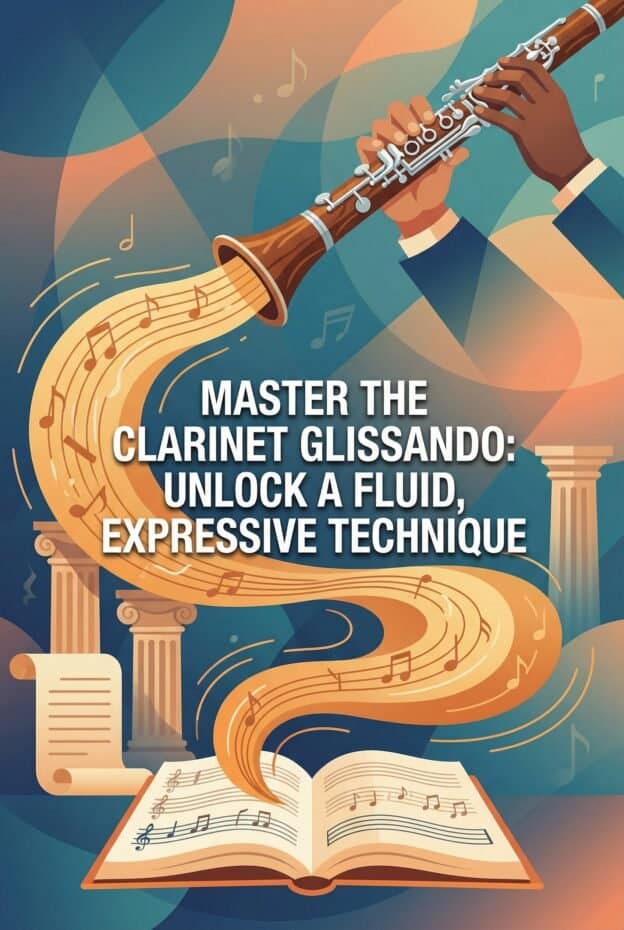What is clarinet glissando? Clarinet glissando is a continuous slide between two notes created by coordinated embouchure loosening, steady air, and gradual “peeling” of fingers from tone holes. Start with a 3-step drill: 1) Slide C to B by bending pitch with embouchure, 2) add slow finger peeling, 3) extend to E to B, keeping air constant and the slide smooth.
What is clarinet glissando (and how it differs from portamento)
Clarinet glissando is a continuous, audible slide between two pitches where the listener clearly hears the in-between notes. On clarinet, this effect comes from a mix of embouchure pitch bending, controlled air, and gradual uncovering or covering of tone holes with the fingers. The result is a smooth, vocal-like swoop rather than a series of separate steps.
Portamento on clarinet is related but usually subtler. It suggests a gentle connection or “carry” between notes, often with a smaller or less obvious pitch sweep. In classical playing, portamento may involve a tiny slide or expressive timing, while full glissando is a deliberate, extended slide, like the famous opening of Gershwin's “Rhapsody in Blue” on B-flat clarinet.
Many players use the words glissando and portamento interchangeably, but teachers often separate them by degree and style. Glissando is the full, unmistakable slide, common in jazz and showy cadenzas. Portamento is more about expressive connection, often used in Romantic and early 20th century repertoire where a huge swoop would sound stylistically out of place.
Brief historical context and notable performers
Glissando on clarinet grew out of vocal and string portamento practices in the 18th and 19th centuries. Singers and violinists used gentle slides to connect expressive notes, and clarinetists gradually adapted similar effects. Early clarinet treatises by authors like Carl Baermann and Hyacinthe Klosé mention expressive pitch inflection, though not the extreme slides heard later.
By the Romantic era, composers such as Carl Maria von Weber and Johannes Brahms wrote clarinet lines that invite subtle portamento, especially in lyrical passages. Clarinetists used small, tasteful slides to imitate the human voice. These were usually short and discreet, far from the dramatic glissandi that would become famous in the 20th century.
The explosion of jazz in the early 1900s changed how clarinet glissando was used. Players like Sidney Bechet and Johnny Dodds used wide, vocal-like slides in New Orleans and early Chicago jazz. Later, Benny Goodman popularized the clarinet glissando worldwide with the iconic opening of George Gershwin's “Rhapsody in Blue” in the 1930s, combining finger peeling with embouchure bending.
Film composers and studio clarinetists quickly adopted the sound. 1930s and 1940s Hollywood scores often used clarinet glissandi to signal comedy, surprise, or romantic swoops. The effect became a sonic shorthand that audiences recognized instantly. Jazz clarinetists such as Artie Shaw and Buddy DeFranco also used glissandi to add personality to solos and transitions.
Historical instruments influenced how players approached glissando. 19th century French clarinets, including models associated with the Martin Freres legacy, had different bore profiles and keywork that encouraged flexible tone and pitch shading. Archival parts and method books from that period show how clarinetists borrowed vocal portamento ideas and gradually expanded them into more obvious slides.
Anatomy & acoustics that enable pitch sliding (tone holes, keys, bore, embouchure)
Clarinet glissando works because the instrument does not jump instantly from one acoustic configuration to another. The tone hole layout, bore shape, and reed-mouthpiece system allow a continuous change in effective tube length. As you gradually uncover holes and adjust embouchure, the resonating air column lengthens or shortens smoothly, producing a slide rather than a step.
Tone hole size and placement are central. Large, widely spaced holes create bigger pitch changes when opened or closed suddenly. For glissando, you avoid sudden changes by peeling fingers slowly so that each hole opens in a controlled, partial way. This keeps the effective length of the tube shifting continuously instead of snapping to the next stable fingering.
Key mechanisms extend your reach to holes that fingers cannot cover directly. During a glissando, you treat these keys like variable vents rather than simple on-off switches. Slightly easing pressure or rolling the finger can partially open a pad, which nudges the pitch upward or downward. This is especially useful on the upper joint, where small changes can move the pitch several cents.
The clarinet's cylindrical bore with a flared bell has predictable overtones that respond strongly to embouchure and air changes. Because the clarinet overblows at the twelfth, embouchure flexibility is important. A slightly looser embouchure and more oral cavity space lower the pitch, while a firmer embouchure and higher tongue raise it. During glissando, you ride this flexibility while coordinating finger motion.
The mouthpiece and reed form a vibrating valve that controls how easily the pitch bends. A more open mouthpiece facing and a slightly softer reed often make glissando easier because the reed responds readily to embouchure changes. Harder reeds and very closed facings can feel locked in pitch, which is great for orchestral stability but less forgiving for wide slides.
Embouchure itself is part of the instrument anatomy in practice. The lower lip, upper teeth, and facial muscles form a variable clamp on the reed. During glissando, you gradually relax the lower lip and jaw while maintaining a stable airstream. This controlled relaxation lengthens the reed's vibrating portion, lowering pitch and allowing a smooth connection between fingerings.
Core mechanics: embouchure, breath, and the “peeling” finger technique
Clarinet glissando depends on three core mechanics working together: embouchure flexibility, steady breath support, and the peeling finger technique. If any one of these is missing, the slide will sound choppy or out of tune. The goal is to feel one continuous gesture rather than three separate actions layered on top of each other.
Embouchure flexibility is the foundation. Start from a well-formed, standard embouchure, then learn to loosen gradually without collapsing. Think of slightly dropping the jaw, cushioning more with the lower lip, and opening the oral cavity. The tongue moves subtly lower and back, similar to saying “ah” instead of “ee,” which helps the pitch slide downward smoothly.
Breath support must stay constant throughout the glissando. Many players unconsciously back off the air when they start to slide, which causes the tone to thin or break. Aim for a strong, unwavering airstream from the diaphragm and abdominal muscles. Imagine blowing “through” the slide, not “at” it, so the sound remains full and centered even as the pitch moves.
The peeling finger technique is what turns pitch bending into a true glissando. Instead of lifting fingers straight up from the keys or holes, you roll or peel them off gradually. The pad of the finger slowly uncovers more of the hole, which raises the pitch in small increments. On the way down, you reverse the process, rolling the finger back to cover the hole smoothly.
To coordinate everything, think of starting the slide with embouchure and air, then letting the fingers “join” the motion. For an upward glissando, you may begin by slightly raising the pitch with embouchure and tongue, then peel fingers one by one so that the pitch continues to climb without sudden jumps. For a downward slide, you may start the embouchure relaxation a fraction of a second before the fingers move.
Hand position affects how easily you can peel. Keep fingers curved and close to the keys, with minimal tension in the knuckles. If your fingers hover high above the keys, you will tend to drop them in discrete steps instead of rolling. Practice slow-motion peeling without blowing, watching how each pad contacts and leaves the key or tone hole in a smooth arc.
Step-by-step exercises and progressive practice plan (C->B, E->B drills and extensions)
This practice plan builds clarinet glissando in clear stages, starting with simple embouchure bends and moving toward full multi-note slides. Aim for 10 to 15 minutes of focused work per day. Keep a practice journal to track which intervals feel clean and which still break or jump.
Stage 1: Embouchure-only pitch bends
Begin with long tones on middle-register notes such as G, F, and E. Hold each note for 8 to 10 seconds. Without moving any fingers, slowly lower the pitch by relaxing the jaw and opening the oral cavity, then return to the center. Use a tuner or drone to monitor how far you can bend without losing tone quality.
Next, practice controlled bends of a specific size, such as a quarter tone or semitone. For example, sustain middle G, then gradually bend it down toward F-sharp without changing the fingering. Listen for a smooth, even motion. This embouchure control will later blend with the peeling technique to fill in gaps between fingerings.
Stage 2: Basic C->B glissando drill
Now focus on the classic C to B slide in the staff, which is an ideal starter interval. Finger C (left hand thumb and first three fingers, right hand first finger) and play a steady, well-supported tone. Begin to relax the embouchure slightly, letting the pitch sag just a bit while keeping the sound full.
As you feel the pitch start to move, slowly peel the right-hand first finger off the hole, rolling from the fingertip toward the base. Aim for a continuous rise in pitch as the hole opens. The goal is to avoid a sudden jump from C to B. If you hear a click or step, slow down and exaggerate the peeling motion.
Repeat the C->B glissando in small groups: three slow slides, rest, then three more. Vary the speed from very slow (2 seconds per slide) to moderate (about 1 second). Keep air pressure consistent. Once you can produce a smooth slide most of the time, add a metronome and practice aligning the start and end of the glissando with specific beats.
Stage 3: E->B glissando and multi-note extensions
Move to a larger interval by sliding from E in the staff down to B. Start on E with left hand thumb and first two fingers plus right hand first finger. Use the same approach: begin with a slight embouchure relaxation, then peel fingers in sequence so that the pitch descends continuously to B without breaking.
Experiment with different finger orders to find the smoothest path. Many players peel the right-hand first finger first, then gradually relax the left-hand second and first fingers. Listen closely for any note that “pops” out. If a particular fingering change causes a jump, slow it down and add more embouchure bend at that moment to smooth the transition.
Once E->B feels comfortable, create three- and four-note glissando patterns. For example, slide from G to D, or from A to E, using a combination of embouchure and peeling. Practice both upward and downward slides. Keep the dynamic steady at mezzo forte so you can hear the pitch clearly without strain.
Stage 4: Rhythmic and stylistic drills
With the basic mechanics in place, add rhythmic structure. Practice glissandi that last for exactly one beat, two beats, or a dotted quarter in various tempos. For instance, in 4/4 time at quarter note = 80, start on C on beat 1 and arrive on B exactly on beat 2, letting the slide fill the entire beat.
Next, imitate stylistic shapes. For jazz, try a quick “scoop” into a note by starting slightly below and sliding up in a short, expressive gesture. For classical portamento, practice very narrow, subtle slides of a semitone or less, timed so they occur late in the note, just before the arrival pitch, to keep the effect tasteful.
Stage 5: Integrating glissando into repertoire
Choose short phrases from your existing pieces where a glissando or portamento might fit stylistically. Mark one or two spots in a jazz standard or a Romantic solo where a slide would enhance expression. Practice the phrase with and without the glissando so you can compare tone, timing, and musical impact.
Finally, record yourself. Play simple scales, then add glissandi between selected degrees, such as 3 to 4 or 5 to 6. Listen back for smoothness, intonation, and tone consistency. Adjust your embouchure, air, and finger peeling based on what you hear, not just what you feel, to refine your control.
Troubleshooting common problems (intonation, leaks, choppy slides)
Many clarinetists struggle with glissando because small issues in setup or technique become obvious when the pitch moves continuously. The most common problems are choppy slides, unstable intonation, and notes that refuse to connect. Systematic troubleshooting helps you identify whether the cause is embouchure, fingers, air, or the instrument itself.
If your glissando sounds choppy or stepped, the peeling motion is usually too fast or too vertical. Slow the movement down and exaggerate the roll of each finger. Practice silent peeling without blowing, watching in a mirror to ensure that the pad of each finger stays in contact with the key as long as possible before lifting.
Intonation problems often come from inconsistent embouchure or air. If the pitch sags too low or cracks, you may be relaxing the jaw too quickly or backing off the air. Try practicing the same slide at a softer dynamic, focusing on a stable airstream. Use a tuner to see where the pitch drifts most, then isolate that portion of the slide for focused work.
Sudden jumps between notes can indicate that one particular fingering change is causing trouble. For example, moving from left-hand second finger to first finger might create a noticeable step. Identify exactly where the jump occurs, then experiment with partial venting: delay the full lift of the finger and add more embouchure bend at that instant to bridge the gap.
Instrument leaks can sabotage glissando even if your technique is solid. A small leak under a pad or at a tenon joint can cause certain notes to respond poorly or crack during slides. If you notice that the same note always misbehaves, especially at soft dynamics, suspect a leak and run a few simple tests before blaming your technique.
Finally, fatigue can make glissando unreliable. If your embouchure tires, you may over-loosen the jaw or clamp too hard, both of which distort the slide. Limit intense glissando practice to short sessions, and pair it with standard long tones and articulation work so that your overall embouchure strength and flexibility continue to develop in balance.
Repertoire, styles and listening examples (classical, jazz, contemporary)
Clarinet glissando appears in a wide range of repertoire, from symphonic showpieces to small jazz combos and contemporary experimental works. Listening closely to masters in each style will shape your concept of sound and timing. The same technical skill can produce very different musical results depending on context.
In classical music, the most famous example is the opening clarinet solo of George Gershwin's “Rhapsody in Blue.” Many performers, including Benny Goodman and Sabine Meyer, use a dramatic glissando that starts from a written scale but morphs into a continuous slide. Notice how the slide accelerates toward the top, matching the orchestra's swell.
Earlier Romantic repertoire by composers such as Carl Maria von Weber and Richard Strauss often invites subtle portamento rather than full glissando. In Weber's Concertino and Strauss's “Till Eulenspiegels lustige Streiche,” clarinetists sometimes use tiny slides to connect expressive leaps, especially in solo passages. These are usually narrow and carefully timed to stay within stylistic expectations.
Jazz clarinetists like Sidney Bechet, Benny Goodman, Artie Shaw, and Eddie Daniels showcase a broad palette of glissandi and scoops. Listen to Bechet's recordings for wide, vocal-like slides and expressive portamento between blue notes. Goodman's big band solos often feature quick upward scoops into accented notes, while Daniels uses refined, controlled slides in modern jazz contexts.
Contemporary classical and experimental composers exploit glissando as a coloristic effect. Works by Krzysztof Penderecki, Luciano Berio, and Jörg Widmann include written glissandi that span large intervals, sometimes combined with multiphonics or microtones. These pieces demand precise control of embouchure and finger venting, often beyond what is needed for standard jazz or Romantic slides.
Film and television scores frequently use clarinet glissandi for comedic or whimsical moments. Classic cartoons and mid-20th century soundtracks often feature a clarinet sliding up or down to mimic laughter, surprise, or a character slipping. Studying these recordings can help you match timing and character when you use glissando in theater pits or studio work.
Maintenance, instrument setup checks and teacher tips
Reliable clarinet glissando depends not only on technique but also on a healthy instrument and sensible setup. Before you blame yourself for every rough slide, check that your clarinet, mouthpiece, and reed are working in your favor. Simple maintenance steps can remove hidden obstacles and make pitch bending much easier.
Start with a basic leak check. Assemble the clarinet and play very soft long tones on low E, F, and G. If any note is hard to start, unstable, or cuts out during a slow glissando, suspect a leak. You can also gently cover the bell with your hand and blow a low E; if you feel air escaping around tone holes or tenons, a pad or cork may need attention.
Inspect pad seating visually under good light. Look for pads that are off-center, compressed unevenly, or discolored at the edges. Small leaks around the upper joint or throat keys can especially disrupt smooth glissandi. If you suspect an issue, schedule a visit with a qualified technician rather than trying to adjust key heights or spring tension yourself.
Apply cork grease sparingly to tenon corks so joints fit snugly without excessive force. Loose joints can leak air and affect response during delicate slides. Check that all keywork moves freely without sticking. A tiny bit of key oil, applied by a technician, can prevent sluggish keys that might lag during fast peeling motions.
Reed selection plays a big role in glissando ease. Slightly softer reeds, or reeds that are well broken in, usually respond more flexibly to embouchure changes. Many players find that a reed about a quarter to a half strength softer than their standard orchestral setup makes wide glissandi more comfortable without sacrificing too much control.
Examine your mouthpiece for chips, warping, or buildup on the rails and table. A clean, well-shaped mouthpiece helps the reed vibrate freely, which is important for smooth pitch bending. If you are consistently struggling with flexibility, consult a teacher or technician about trying a slightly more open facing that encourages easier response.
Teachers can help by introducing glissando in a structured way rather than as a party trick. Start students with embouchure bends and simple C->B slides, then gradually add larger intervals and stylistic applications. Encourage students to listen to specific recordings and imitate the timing and shape of glissandi, not just the raw effect.
Finally, set realistic milestones with your students or for yourself. Expect a clean adjacent-note slide such as C->B after 1 to 2 weeks of consistent practice, reliable multi-note portamento like E->B within 4 to 6 weeks, and confident use in jazz or classical repertoire after about 8 to 12 weeks of structured work.
Key takeaways
- Clarinet glissando combines embouchure flexibility, steady air, and gradual finger peeling to create a continuous slide, while portamento is usually a subtler, stylistic connection between notes.
- Understanding clarinet acoustics, especially tone hole behavior and reed-mouthpiece response, makes it easier to plan and control smooth, in-tune slides.
- Progressive drills from C->B to E->B and beyond, practiced 10 to 15 minutes daily, typically yield reliable glissando within a few weeks for most intermediate players.
- Choppy slides, intonation issues, and unresponsive notes often trace back to specific finger transitions, embouchure inconsistencies, or instrument leaks that can be isolated and fixed.
- Thoughtful maintenance, flexible setup choices, and guided listening to historical and modern performers help you use glissando musically across classical, jazz, and contemporary styles.
FAQ
What is clarinet glissando?
Clarinet glissando is a continuous slide between two notes created by combining embouchure pitch bending, steady air support, and gradual peeling of fingers from the keys or tone holes. Instead of hearing discrete steps, the listener perceives one smooth, vocal-like motion that passes through the pitches between the starting and ending notes.
How do I practice a basic clarinet glissando (starter drill)?
Begin with a C to B slide in the staff. Play a steady C, then slightly relax your embouchure to let the pitch move while keeping air constant. Slowly peel the right-hand first finger off the tone hole so the pitch rises continuously to B. Practice very slowly at first, aiming for a smooth, unbroken slide.
What is the difference between glissando and portamento on clarinet?
Glissando is a clear, often wide slide where you hear the pitch travel between two notes, common in jazz and showy classical passages. Portamento is usually a narrower, more discreet connection or “carry” between notes, often used in Romantic and early 20th century music to imitate vocal phrasing without a dramatic swoop.
Which reeds, mouthpieces or instrument setups help make glissando easier?
A slightly softer reed and a moderately open mouthpiece facing usually make glissando easier because the reed responds more readily to embouchure changes. A well-maintained clarinet with good pad seating and no leaks is important. Many players use a setup about a quarter to a half strength softer than their standard orchestral configuration for flexible slides.
Why does my glissando jump or go out of tune and how do I fix it?
Jumps often occur when a finger lifts too quickly or vertically instead of peeling, causing a sudden change in tube length. Slow the motion and roll the finger off the key. Intonation problems usually come from inconsistent embouchure or air, so practice long-tone bends and use a tuner to smooth out the pitch curve through the entire slide.







